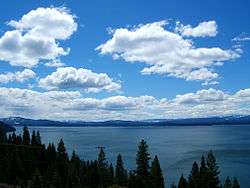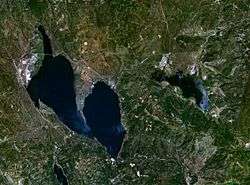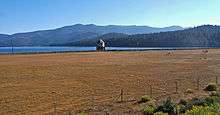Lake Almanor
| Lake Almanor | |
|---|---|
 Lake Almanor from Johnson's Grade | |
| Location | Plumas County, California |
| Coordinates | 40°15′10″N 121°09′37″W / 40.252778°N 121.160278°WCoordinates: 40°15′10″N 121°09′37″W / 40.252778°N 121.160278°W |
| Type | reservoir |
| Primary inflows | North Fork of the Feather River, Hamilton Branch, Benner and Last Chance creeks |
| Primary outflows | North Fork of the Feather River |
| Basin countries | United States |
| Max. depth | 90 ft (27 m) |
| Surface elevation | 4,505 ft (1,373 m) |
Lake Almanor is a large reservoir in northwestern Plumas County, northeastern California. The reservoir has a capacity of 1,308,000 acre feet (1.613×109 m3) and a maximum depth of about 90 feet. It is formed by Canyon Dam on the North Fork of the Feather River, as well as Benner and Last Chance Creeks, Hamilton Branch, and various natural springs.
Creation
The dam is 130 feet tall and composed of hydraulic fill.

The first dam was completed by Great Western Power in 1914[1] as part of the Upper North Fork Feather River Project, damming the North Fork of the Feather River and flooding the meadow-filled valley generally known as Nakam Koyo/Big Meadows/Big Springs, a longstanding Yamani Maidu village site.[2][3] When the dam was built, Maidu families still living in the vicinity were displaced while parts of the town of Prattville had to be moved to higher ground, leaving multiple structures flooded over. The reservoir was named for the three daughters of Guy C. Earl, Vice President of Great Western Power: Alice, Martha and Eleanor.[4][5] The present dam, which more than doubled the size was constructed by Great Western Power from 1926 to 1927.
The dam is now owned by Pacific Gas and Electric Company. PG&E uses it for hydroelectricity production, but the lake is also a popular recreation area, with fishing, boating, water skiing, swimming and camping available.
Geography

The lake-front and immediate surroundings are, either officially or unofficially, divided into a series of regions:
- North Shore typically referring to the north-east shoreline and the campground of the same name.
- The Peninsula being the major east-side peninsula bisecting the lake and largely taken up by the Lake Almanor Country Club, the community of Almanor, and the more recent residential developments known as Bailey Creek and Foxwood.
- Hamilton Branch being the east-side community next south from the Peninsula, named for the river of the same name.
- East Shore being both the developed and undeveloped areas between Hamilton Branch and the dam itself.
- Canyon Dam (also known as Canyondam), the community just southeast of the dam.
- South Shore, the southwest shoreline taken up largely by PG&E managed campgrounds and undeveloped grounds;
- Prattville being the small resort community on the southwest shoreline; retains the same name as the town that was once in Big Meadows (now under water).
- West Shore being on the upper southwest shore and more formally referred to as Lake Almanor West, itself an un-gated country-club.
- The generally nameless western shoreline from Lake Almanor West to the town of Chester, starting at Goose Bay and ending at the termination of the large diversion channel that mitigates high-waters in the Feather River above Chester.
- The northern shoreline from Chester, running northeast then southwest, and back to Hwy 36; includes the mouth of Benner and Last Chance creeks and seasonal springs.
Much of the southern shore of the lake is in the Lassen National Forest, so recreation management is shared by PG&E and the United States Forest Service.
Large areas along the northern shore of the lake are seasonal pasture used for summer and fall cattle grazing; some areas of these grazing grounds are under-water in wetter years. The wetlands at the north end also serve as breeding grounds for a variety of migratory waterfowl, most prominently Canada geese and various species of ducks including mallard, teal, and wigeon. Other large birds to be viewed around the lake are heron, osprey, and occasionally bald eagles, which nest on the Peninsula and West Shore. Each year in late June and early July, large insect hatches occur on the lake during the dusk hours. The insects, which the fish feed on, attract local fly fisherman who use imitation flies to catch the feeding fish.
The Almanor Basin Watershed Advisory Committee Group (ABWAC) received funding for a Watershed Assessment Project under California Prop 12, and one deliverable from this project was in an online map-based database of watershed information that runs in Google Earth - download the tour at: http://www.sierrainstitute.us/Almanorvirtualtour.html
Thermal Curtain
PG&E's 50 year license to use the waters of Lake Almanor were set to expire in 2004 when the state water board explored requests to install a thermal curtain[6] at the bottom of Lake Almanor to control the temperature of the rivers downstream. This was ostensibly to create better habitat for trout habitat up to 40 miles downtsream. However, residents near Lake Almanor became concerned that the curtain would help the trout downstream at the cost of raising the water temperatures of shallow Lake Almanor and harming its fish population. By doing so the residents would not have easy access to the lakes fish population. [7]
Power production
There is no powerhouse at the dam. Image of the Outlet tower to the Butt Valley Powerhouse tunnel near Prattville A tunnel (and finally a penstock) from the powerhouse outlet tower, in the lake between Prattville and the Plumas Pines Resort, delivers water to the Butt Valley Powerhouse at the north end of Butt Valley Reservoir, which has a capacity of 41 MW. From there, the water is sent by tunnel to either the Caribou 1 (74 MW) or Caribou 2 (120 MW) powerhouses. Caribou 2 is favored because it is newer and more efficient. Their tailraces flow into Belden Reservoir. A portion of the water goes through the 1.3-MW Oak Flat Powerhouse, which is located at the bottom on Belden Dam. The rest goes to the 125-MW Belden Powerhouse by another tunnel. The water is then released into Rock Creek Reservoir. All of these powerhouse facilities are presently (2008) owned and operated by the Pacific Gas and Electric Company (PG&E), a major investor-owned California utility.

See also
- List of lakes in California
- List of dams and reservoirs in California
- List of largest reservoirs in the United States
- List of largest reservoirs of California
- Indigenous peoples of California
References
- ↑ http://www.citlink.net/~lahontan/almanor.htm
- ↑ Golla, Victor. 2011. California Indian Languages. University of California Press
- ↑ The Northern Maidu. Roland B. Dixon. 1905. Bulletin of the Museum of Natural History Vol. XVIII, Part III, pp. 119-346. Huntington California Expedition
- ↑ 1500 California Place Names: Their Origin and Meaning by William Bright. University of California Press, Berkeley and Los Angeles, 1998.
- ↑ Gudde, Erwin; William Bright (2004). California Place Names (Fourth ed.). University of California Press. p. 9. ISBN 0-520-24217-3.
- ↑ http://www.familywateralliance.com/farm_oct04_plumas.html
- ↑ http://www.newsreview.com/chico/murky-options/content?oid=1450695
- U.S. Geological Survey Geographic Names Information System: Lake Almanor
- Bright, William. 1500 California Place Names: Their Origin and Meaning. University of California Press, Berkeley and Los Angeles, 1998.
- Dixon, Roland B. Dixon. 1905. The Northern Maidu. Bulletin of the Museum of Natural History Vol. XVIII, Part III, pp. 119–346. (Huntington California Expedition).
- Golla, Victor. 2011. California Indian Languages. University of California Press.
- Pacific Gas & Electric
- United States Forest Service
- Western Pacific Lives
- 2105 Project Facts
- Power Company Creating New Lake in the Sierras
- Old Prattville Town Wiped Off The Map
External links
| Wikimedia Commons has media related to Lake Almanor. |